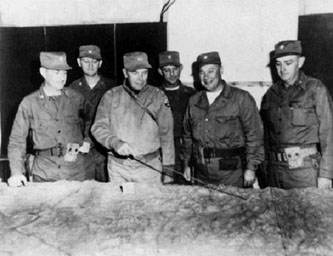On 25 June 1950, the North Korean Army invaded South Korea. Over the next several weeks, as South Korean and American forces retreated before the onslaught, U.S. Army planners in Tokyo searched for a way to stem the enemy advance and relieve pressure on besieged Allied forces within the Pusan Perimeter.
One of those planners was Corps Engineer LTC Edward Rowny who was assigned to General MacArthur’s Far East Command headquarters in Tokyo. In his oral history interview Rowny recalled that during those hectic first weeks he and several other members of the Plans Section proposed a daring solution- an amphibious landing behind enemy lines.
The planners proposed three invasion sites. Rowny’s choice, a full 25 kilometers behind the enemy lines, was the boldest. When it came time to brief General MacArthur, Rowny feared that the general would dismiss the plan as foolish and risky. The Engineer colonel needn't have worried, for MacArthur not only endorsed the amphibious attack, but also insisted on a far more ambitious target. Striding to the briefing maps MacArthur picked up a grease pencil and pointed to the port of Inch’on, 100 kilometers up the coast and directly opposite the South Korean capital, Seoul. "One should land as close as possible to the objective" MacArthur said, "and the objective is the capital. You’re all too timid. You’re pusillanimous. You should think boldly and decisively."
In the discussions that followed, the planners told the general that they had considered landing at Inch’on, but rejected the site because they feared the port would be heavily defended. They also were concerned that the port’s 31-foot tides would make an amphibious landing extremely difficult. MacArthur brushed their reservations aside. "Go for the throat," MacArthur told his officers, and "Seoul is the objective. And as for the tides," the general said, "don’t take counsel of your fears. Physical obstacles can be overcome by good planning, strong nerves, and will power."
At General MacArthur’s request, Rowny and his colleagues developed a detailed plan for the Inch’on invasion. A short time later, after MacArthur won approval for the landing from the Joint Chiefs of Staff, he called the Plans Section into his office. Putting his arm around Rowny the general announced that "Inch’on shall go down in history as the twenty-second Great Battle of the World."
On 15 September 1950, U.S. forces stormed ashore at Inch’on and quickly drove eastward, severing the enemy’s communication and supply lines. With its supply line cut and a formidable force at its rear, the North Korean Army besieging Pusan quickly began retreating northward. The tide of battle, had for the moment, changed.

LTC Edward Rowny (second from left) studies a sand table terrain map at X Corps headquarters in Korea with MG Edward M. Almond (with pointer), commander of X Corps, and other staff members, 2 Oct 1950.
* * *
2000